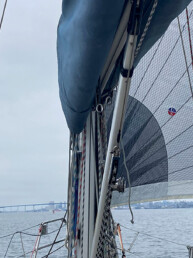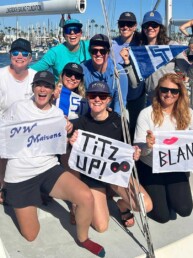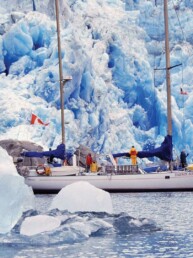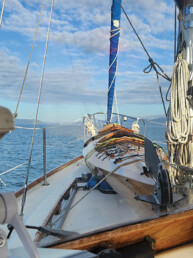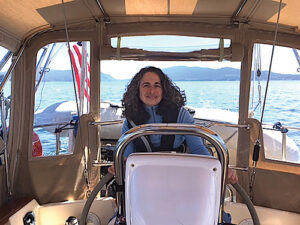
As first mate of our Island Packet 350, Kagán, there were times when I thought I could capably skipper the boat I’d cruised around the Pacific Northwest for years. It usually followed a tense situation — perhaps a not-so-smooth docking or a misunderstanding while anchoring — and perhaps an also-tense debriefing with my partner, Jerry. If you cruise, I’m sure you’ve had similar moments.
With the benefit of hindsight, it was easy to second-guess his split-second decisions and consider how I would have chosen to handle the same scenario. That is, until it was my turn to be making those calls.
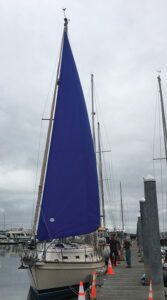
Thinking about one’s own capabilities and believing in them can be miles apart. In this case, nautical miles.
Jerry and I cruised toward the end of the 2012 sailing season, our eighth on Kagán as our summer home. As usual, with me headed back to work, Jerry stayed aboard another month to complete boat projects and tidy up for the offseason. Shortly after he returned to our land-based home in New Mexico, he admitted he hadn’t been feeling so well for some time. Not one to interrupt his favorite activity — cruising Kagán — he’d simply pushed through the symptoms.
After months, with his symptoms worsening, they could no longer be ignored. It was colon cancer. Stage 4. Though it seemed clear this would be terminal, Jerry elected to have surgery with the hope he would live to sail one more season. But the cancer was aggressive, and a mere four months after his diagnosis, Jerry drew his last breath. At peace with his life, he let go of it with grace. It was a privilege, not a hardship, to be with him.
In his final weeks, he’d tied up the few remaining loose ends of his life. One of those was asking if I would sail Kagán, as he couldn’t bear to think of her tethered to a dock more than not. I said I would, and after giving him that promise, he gave me two of the greatest gifts I have ever received — Kagán, the beautiful boat that has been my summer home in the Pacific Northwest since 2005, and a week-long cruise-and-learn aboard Kagán with Captain Nancy Erley to help me transition from first mate to skipper.
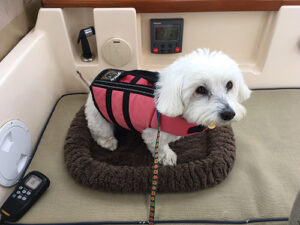
After months of dealing with Jerry’s end-of-life matters, Capi (Kagán’s intrepid little boat dog) and I made it to the boat barely two weeks before Nancy was scheduled to arrive. Maple Bay Marina on Vancouver Island had been our homeport for five years by then. They’d sent flowers after Jerry’s surgery and all our fellow sailors knew what had happened, so I knew I’d be surrounded by sympathetic friends. But I admit to being relieved that there was no one on the docks when Capi and I walked down the steep ramp at low tide. In that moment, I didn’t feel like talking — not about Jerry, or the last few months, or what lay ahead.
The mid-day sun shone, and a light breeze fluttered the flags on neighboring boats as I unhooked Kagán’s gate and stood on tiptoes to place the bags that hung on each of my shoulders into the cockpit. I scooped Capi up in my arms and climbed into the cockpit. She sat on my lap, looking around, sniffing at the air, and I imagined her little black nose detecting familiar, favorite summer smells. Those would be some of the last moments of stillness for some time. Jerry had done a thorough decommissioning, which meant a thorough recommissioning was in my immediate future, and I’d never been aboard for that before. I had just lived through a lot of “last times,” now there were going to be a lot of “firsts.”
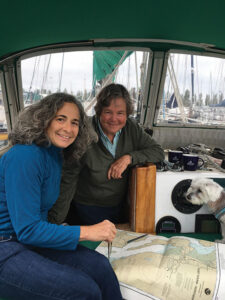
I unlocked the padlock that secured Kagán, slid the hatch open, pulled the boards out one by one by one, and descended the companionway to the cabin. It felt like Jerry was right there. It would be several seasons before I didn’t feel his presence in every nook, cranny, and compartment on Kagán. It would take at least as long before I didn’t feel his shadow over my shoulder, especially if I did something differently than I thought he might have.
A wave of grief washed over me. It wasn’t like I’d never been acquainted with that feeling, Jerry and I had met in the first place because we’d both lost spouses, mine in an accident and his to cancer. We used to say our paths crossed because of grief, but we’d decided to walk the same one because of sailing.
Between early morning dog walks, laps back and forth to the storage unit, and crying jags, I managed to complete the commissioning list I’d cobbled together from Jerry’s scribbled notes. The night before Nancy joined us, I sat in the cockpit stroking the cottony softness of Capi’s head as the long twilight of the far-north summer evening faded to night. Capi shuffled backwards on the cockpit cushion and clasped my hand between her front paws.
“What?” I asked, looking down at her.
She peered up at me with her deep brown eyes.
I laughed at her earnestness. But her presence did calm me, a little.
“You’re right. I am nervous.”
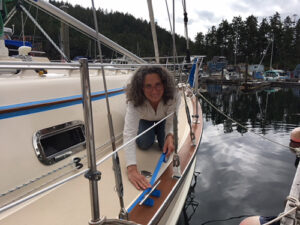
I thought I could skipper Kagán, but reflecting back, I didn’t believe it. What I did believe was this — if Nancy could teach me to get out of and into my very narrow slip, I would figure out the rest. When she arrived, we exchanged a few niceties on the dock and she wasted no time stowing her gear while saying, “I want you to get the most learning you can from our time together. Why don’t you start by giving me Kagán’s safety orientation, then we’ll get the engine warmed up.”
“Already?” I wondered.
“Sure, Deb. You said you’ve done the engine checks and prepared the cabin, right?”
I had, using the mechanical and cabin ready-to-go lists Jerry and I had composed and put on index cards we’d laminated. The same ones I still use.
“Let’s get out there and start our learning,” she said.
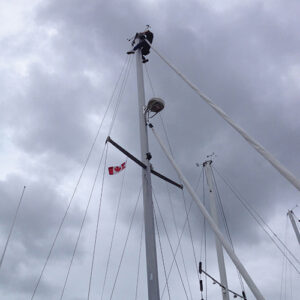
We donned life jackets and re-tied the dock lines for an easy exit, then talked through how we’d leave the slip. Nancy had sensed my unease and hoped that off the dock and out on the water, focused on the tasks at hand, I’d forget my fears. We had talked on the phone, planning the cruise, so she had an inkling of what I knew and what I didn’t — or what I thought I knew or didn’t. She was aware that I was fragile and frazzled, grieving Jerry and trying to do everything on Kagán just as he would — in other words, as perfectly as possible. I would learn that some of his choices weren’t so perfect, but Nancy was wise enough to know that wasn’t the time to talk about it.
“Will you pull her out?” I asked, looking at the bigger- and beamier-than-usual powerboat on the dock behind us.
She smiled. “I’ll be right here.”
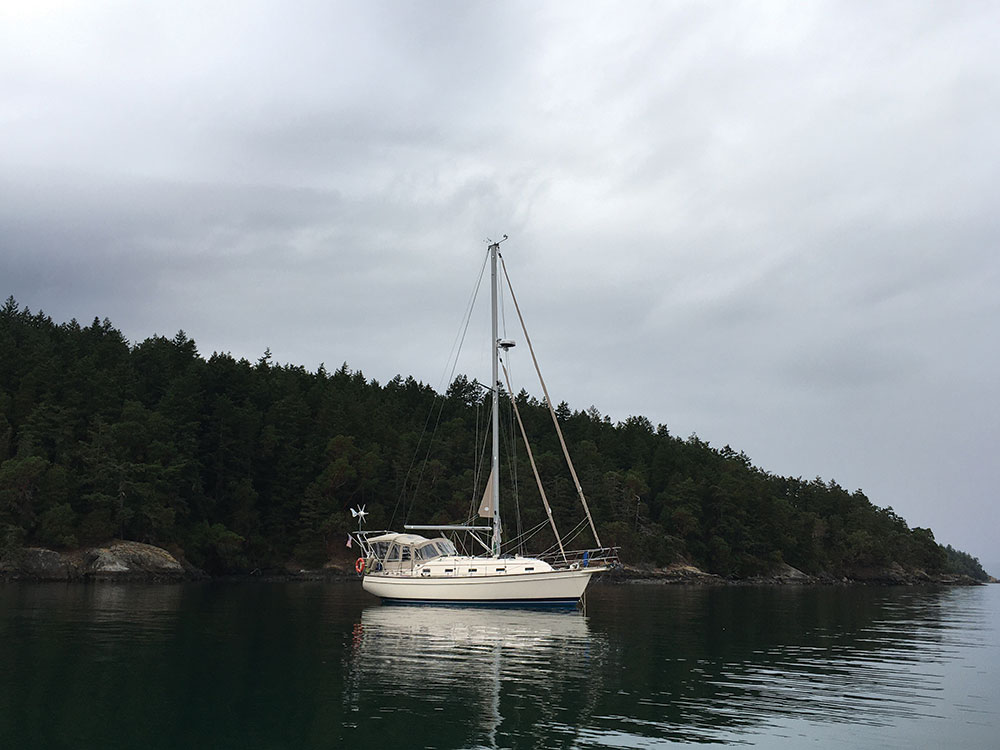
I shifted into reverse idle and eased back, then turned to port, checking our position from various angles, especially over my left shoulder at that boat I was worried about. With the slightest of hand motions, Nancy suggested I steer to starboard a bit.
“The bow is clear,” she said. “Try forward now. Easy though.”
She was right there, strong and reassuring, but making sure I was doing it, whatever it was.
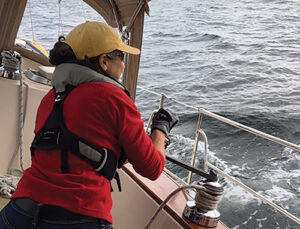
Another tack she’d take was to ask me something about Kagán, casually, as sailors are wont to do about other people’s boats. I would answer, often in detail, so without her pointing out that I knew one thing or another, she would help me see for myself that I did.
We talked about the role I had played as first mate in setting sails in gusty winds or anchoring in deep, remote coves. Just because I hadn’t been at the helm didn’t mean I hadn’t done it. Then she gently suggested I could also do it on my own, with sensible adjustments. And I would, with Nancy ‘right here’ for encouragement.
So, what about getting into that tight slip? We took it incrementally. After hauling anchor in Montague Harbor, Nancy pointed over to the field of mooring buoys, which were being vacated one by one. “Let’s practice going alongside, but with a mooring buoy. You can imagine that it’s a dock, but it’s no big deal if you knock into it. It’ll give you a sense of where and how you want to turn, and the best angle for approach.”
We did several touch-and-go approaches and it was, incredibly, not scary — it demystified the process. And I did pretty well, which made it feel kind of fun and built my confidence for what was to come.
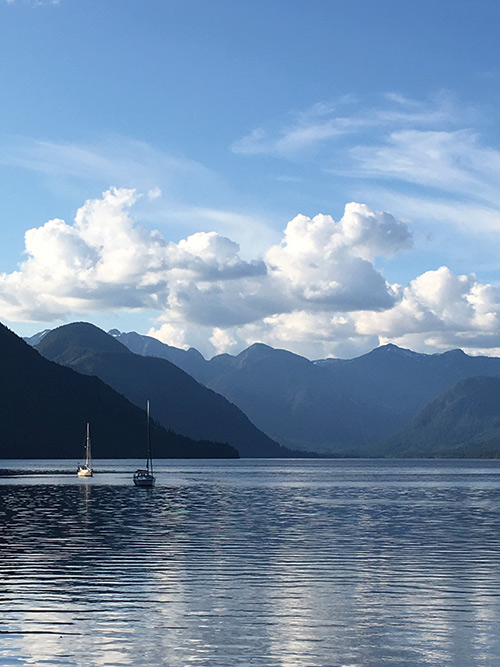
The week of hands-on learning flew by — sailing, anchoring, using the outboard, going over Kagán’s systems, and long talks about my goals as Kagán’s captain.
The final increment of docking training came during Nancy’s last afternoon aboard. I had forgotten that every time Jerry and I came alongside, Capi would bark like mad; presumably excited for her upcoming shore leave. That was all fine and good, but it made concentrating and any crew communication difficult, to say the least.
We planned to do a number of touch-and-go practices on an end dock before heading down the fairway to pull into the slip. I was reminded of Capi’s quirk from the first approach and with every one after — BARK, BARK, BARK, BARK! With each circle out and around, she’d settle long enough for Nancy to give me some input. Seemingly calm as can be, Nancy embodied cool confidence. Despite the distractions, I made some nice landings along the linear dock, and none were disastrous.
Nancy had a ferry to catch, so before long, it was time to circle one last time, then turn into the fairway for home.
“Will you pull her into the slip?” I asked. Nancy just smiled. I gave her a nervous one in return, and said, “I know, you’ll be right here.”
“We know Kagán fits, so don’t even look at the boat next door. Look at the dock and pull up to it, just like you’ve been doing. That’s your job right now, and you can do it!” Nancy encouraged.
And just like that, I docked Kagán in her slip. Maybe there was a bit of beginner’s luck involved, but I greased that first landing. It felt amazing! After getting Capi her much-anticipated shore leave, I reboarded the boat with her in my arms, climbed down the companionway, and leaned in the doorway of the aft cabin while Nancy packed her bag.
“By the way,” she said, “don’t worry about having help on the dock when you’re singlehanding. Everyone will hear you coming. You’ll make sure of that, won’t you, Capi?” Nancy reached over and tussled her ears.
We laughed and hugged, and I might’ve cried too. After so many tough, though sometimes beautiful, transitions in the past months, that week with Nancy was life-changing in the best possible way. I often remark that Nancy Erley changed my life that week, but she is always quick to point out that I changed my life. Her skills as a teacher made it possible for me to do so — she made me see I could skipper Kagán. In fact, I already was, even that week.
I thought I would singlehand Kagán one day, but surely not my first season as skipper. The week after my time with Nancy, a friend came out to cruise with me, and I put all I’d learned into practice. Two weeks after, I pulled out of my slip with only my little furry first mate, Capi, and no one else. We motored south through Sansum Narrows and, while approaching Cowichan Bay, a light wind filled in behind us. I unfurled the head sail and ghosted toward Satellite Channel, the rippled seas chuckling along Kagán’s hull. Nancy declares that our boats are ‘magic carpets’— and there I was, riding mine!
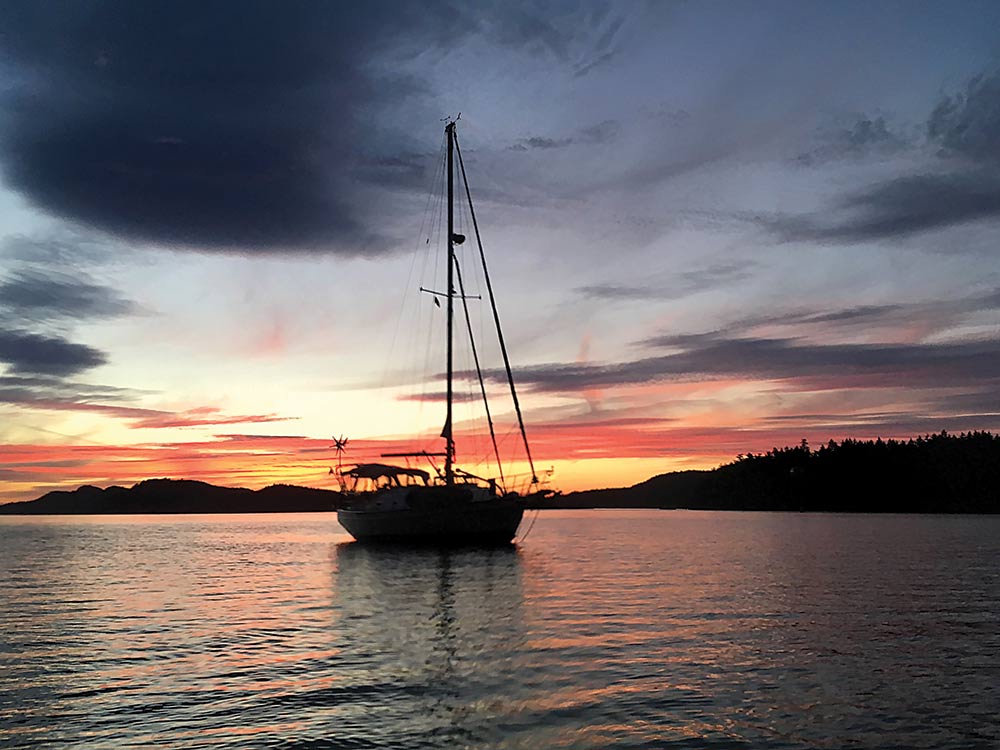
Turning east, I trimmed the jib for a beam reach. At about three knots of boat speed, and the current with us to the tune of another half a knot, there were no fireworks, the rail wasn’t in the water, but the quiet exhilaration was like nothing I’d ever felt before. I was the captain of my fair little ship and sailing her. Nine years later, I feel every bit as much joy in those moments as I did in the first one. If you have the chance to claim that for yourself, I hope you will seize the moment, take the chance!
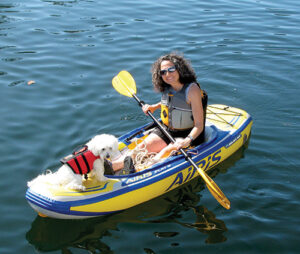
As Eleanor Roosevelt said, “You gain strength, courage, and confidence by every experience in which you really stop to look fear in the face. You must do the thing you think you cannot do.” For me, the rewards can be measured in so much more than nautical miles.
D. J. Green (www.geologistwriter.com) is a writer, geologist, and sailor who cruises the Salish Sea on her cutter, Kagán, during the summers. Her first novel, Inundations, is forthcoming from She Writes Press in spring 2024.

